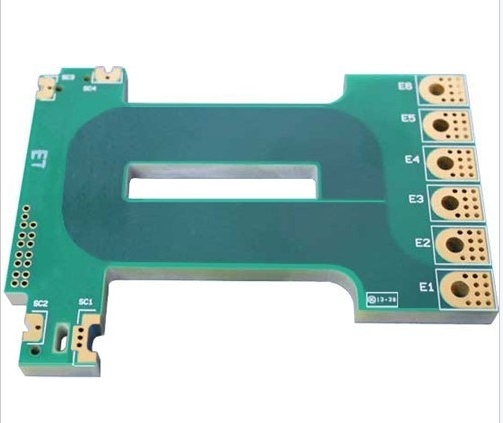E-mail: jack@crown-key.com
Welcome to visit Crown Key Electronics website, let's connect the world together!
Why We need high reliability PCB?
High reliability is a practical science that combines "engineering technology" and "management art". To produce high-reliability PCBs steadily, a set of "standardized, efficient, collaborative, and controllable" management procedures must be established, and factories must be fully managed and controlled. "Engineering design, production materials, manufacturing equipment, process technology, quality assurance facilities, production environment, management system, team quality" and a series of influencing factors.
PCB(Printed Circuit Board), mechanically supports and electrically connects electrical or electronic components using conductive tracks, pads, and other features etched from one or more sheet layers of copper laminated onto or between sheet layer of non-conductive substrate. Components are generally soldered onto the PCB to both electrically connect and mechanically fasten them to it.
According to official statistics, PCBA's compensation caused by reliability failure accounts for more than 90% of the external failure cost! According to GE's analysis, it is worthwhile to increase the reliability by 1% and the cost by 10% for equipment for continuous operations such as energy, transportation, mining, communications, industrial control, and medical treatment. With high reliability of PCBA, maintenance costs and downtime losses can be greatly reduced, and asset and life safety is more guaranteed!
High-reliability PCB can play the role of a stable carrier to realize the long-term and stable operation of PCBA, thereby ensuring the safety, stability and service life of terminal products, and enterprises can enhance competitiveness, improve reputation, expand market share, and improve economic benefits. .
If reliability PCB is so important for the whole electronics products, how could we evaluate whether the PCB is reliable?
High reliability is a practical science that combines "engineering technology" and "management art". To produce high-reliability PCBs steadily, a set of "standardized, efficient, collaborative, and controllable" management procedures must be established, and factories must be fully managed and controlled. "Engineering design, production materials, manufacturing equipment, process technology, quality assurance facilities, production environment, management system, team quality" and a series of influencing factors.
Therefore, to evaluate whether the PCB has "high reliability", it is necessary to deeply confirm whether the following control items of the factory have been fully controlled.
1. Prevention mechanism
1) Engineering design: customer requirements identification, information management, automated operations, professional skills; design standards and specifications, based on factory process capabilities to modify manufacturability; work specifications, process standardization, and engineering production automation;
2) Manufacturing process: systematic and systematic management of the control objectives, operating procedures and operating specifications of each process of the entire process;
3) Quality control management: standardize quality control standards, improve the quality assurance system, and assist the process to improve quality;
2. Process management
1) Quality and product safety system: IATF16949, ISO9001, GJB9001, UL, CQC, RoHS;
2) Engineering design: DFM specifications such as laminated structure, impedance, min line width, min spacing, min hole diameter, copper thickness, etc.; production process design, material selection, manufacturability document design, etc.;
3) Production materials: supplier review, material evaluation, raw material inspection, raw material storage, etc.;
4) Process technology: Capability, production parameters, use of chemical solution, first FA, etc.;
5) Equipment and facilities: assessment, daily inspection, progress test, predictive maintenance, preventive maintenance, periodic maintenance, etc.;
6) Operating environment: dust-free, constant temperature, constant humidity, illuminance, etc.;
7) Quality control: incoming material IQC, process IPQC, process IPQA, final inspection FQC, shipment OQC, trustworthiness test, etc.;
8) Management team: operating specifications, risk identification, problem analysis, strategy analysis, etc.;
3. Quality assurance audit
1) Quality yield: real-time monitoring;
2) Quality reliability: real-time/regular inspection;
3) Quality consistency: real-time/on-demand audit;
4) Mean time between failures: regular/on-demand verification;
4. Test verification
1) Signal performance: impedance test, signal loss;
2) Heat resistance: thermal stress, Tg test, TMA test;
3) Interconnection performance: IST test, current resistance, thermal shock;
4) Mechanical properties: peel strength, pull-off strength, solder mask hardness, adhesion;
5) Insulation performance: withstand voltage test, damp and heat insulation resistance, CAF resistance test;
6) Welding performance: cleanliness test, solderability test;
7) Corrosion resistance: solder mask resistance to chemical reagents, gold finger porosity.
High-Reliability can make your electronics more perfect. So choose a reliable PCB partner is the most important thing during purchasing.
With more than 10 years working on PCB field, Crown Key have our strict rules for PCB final inspection.

According to official statistics, PCBA's compensation caused by reliability failure accounts for more than 90% of the external failure cost! According to GE's analysis, it is worthwhile to increase the reliability by 1% and the cost by 10% for equipment for continuous operations such as energy, transportation, mining, communications, industrial control, and medical treatment. With high reliability of PCBA, maintenance costs and downtime losses can be greatly reduced, and asset and life safety is more guaranteed!
High-reliability PCB can play the role of a stable carrier to realize the long-term and stable operation of PCBA, thereby ensuring the safety, stability and service life of terminal products, and enterprises can enhance competitiveness, improve reputation, expand market share, and improve economic benefits. .
If reliability PCB is so important for the whole electronics products, how could we evaluate whether the PCB is reliable?
High reliability is a practical science that combines "engineering technology" and "management art". To produce high-reliability PCBs steadily, a set of "standardized, efficient, collaborative, and controllable" management procedures must be established, and factories must be fully managed and controlled. "Engineering design, production materials, manufacturing equipment, process technology, quality assurance facilities, production environment, management system, team quality" and a series of influencing factors.
Therefore, to evaluate whether the PCB has "high reliability", it is necessary to deeply confirm whether the following control items of the factory have been fully controlled.
1. Prevention mechanism
1) Engineering design: customer requirements identification, information management, automated operations, professional skills; design standards and specifications, based on factory process capabilities to modify manufacturability; work specifications, process standardization, and engineering production automation;
2) Manufacturing process: systematic and systematic management of the control objectives, operating procedures and operating specifications of each process of the entire process;
3) Quality control management: standardize quality control standards, improve the quality assurance system, and assist the process to improve quality;
2. Process management
1) Quality and product safety system: IATF16949, ISO9001, GJB9001, UL, CQC, RoHS;
2) Engineering design: DFM specifications such as laminated structure, impedance, min line width, min spacing, min hole diameter, copper thickness, etc.; production process design, material selection, manufacturability document design, etc.;
3) Production materials: supplier review, material evaluation, raw material inspection, raw material storage, etc.;
4) Process technology: Capability, production parameters, use of chemical solution, first FA, etc.;
5) Equipment and facilities: assessment, daily inspection, progress test, predictive maintenance, preventive maintenance, periodic maintenance, etc.;
6) Operating environment: dust-free, constant temperature, constant humidity, illuminance, etc.;
7) Quality control: incoming material IQC, process IPQC, process IPQA, final inspection FQC, shipment OQC, trustworthiness test, etc.;
8) Management team: operating specifications, risk identification, problem analysis, strategy analysis, etc.;
3. Quality assurance audit
1) Quality yield: real-time monitoring;
2) Quality reliability: real-time/regular inspection;
3) Quality consistency: real-time/on-demand audit;
4) Mean time between failures: regular/on-demand verification;
4. Test verification
1) Signal performance: impedance test, signal loss;
2) Heat resistance: thermal stress, Tg test, TMA test;
3) Interconnection performance: IST test, current resistance, thermal shock;
4) Mechanical properties: peel strength, pull-off strength, solder mask hardness, adhesion;
5) Insulation performance: withstand voltage test, damp and heat insulation resistance, CAF resistance test;
6) Welding performance: cleanliness test, solderability test;
7) Corrosion resistance: solder mask resistance to chemical reagents, gold finger porosity.
High-Reliability can make your electronics more perfect. So choose a reliable PCB partner is the most important thing during purchasing.
With more than 10 years working on PCB field, Crown Key have our strict rules for PCB final inspection.


Sign Up to Our Newsletter for PCB Industry News&Exclusive Offers !

Shenzhen Crown Key Electronics Limited
Factory Add:
Building 18, Zone 1, Xinhe Xinxing Industrial Park, Fuhai Street, Baoan District, Shenzhen, China
Marketing Add:
D2902, Phase II, Xufei Huada Garden, No.2083,Buxin Road, Cuizhu Street, Luohu District,Shenzhen China
Contact: Jack Lee
Phone: 008613723481353
Email: jack@crown-key.com







Copyright © 2020 Shenzhen Crown Key Electronics Limited.



